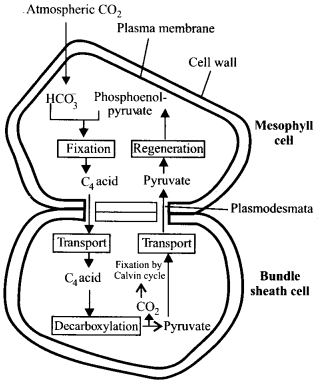For the synthesis of glucose, the source of hydrogen atoms is:
1.
Water
2.
NADPH
3.
FADH2
4.
Monosaccharides
In cyclic photophosphorylation, the primary electron acceptor is:
1. An iron-sulfur protein
2. Plastocyanin
3. Plastoquinone
4. Water
If chloroplasts are illuminated with sunlight, the lowest pH would be observed in:
| 1. | stroma | 2. | intermembrane space |
| 3. | thylakoid space | 4. | cytosol |
To establish a proton gradient across the thylakoid membrane, the protons are provided by:
| 1. | Glucose | 2. | Chlorophyll |
| 3. | Membrane proteins | 4. | Water |
Heme and iron-sulfur complexes in photosynthesis:
| 1. | act as reducing agents |
| 2. | act as oxidizing agents |
| 3. | both oxidize and reduce during electron transport |
| 4. | are needed only in respiration but not in photosynthesis |
Identify the correct statement:
| 1. | The pH within the thylakoid is less than that of the stroma. |
| 2. | The pH of the stroma is higher than that of the other two measurements. |
| 3. | The pH of the stroma is higher than that of the thylakoid space but lower than that of the cytosol. |
| 4. | The pH of the thylakoid space is higher than that observed anywhere else in the cell. |
The pathway shown in the figure will be seen in:
1. plants
2. CAM plants
3. plants
4. All photosynthetic plants
Carbon dioxide fixation will be inhibited by oxygen in:

1. cell I only.
2. cell II only.
3. neither cell I nor cell II.
4. both cell I and cell II.
Radioactive carbon [] was fed to a plant during the day and after a short time was traced to oxaloacetate. The plant used in the experiment will be:
| 1. | C4 plant | 2. | C3 plant |
| 3. | CAM plant | 4. | carnivorous plant |
plants are able to photosynthesize with no apparent photorespiration because of:
| 1. | absence of Calvin cycle. |
| 2. | use of PEP carboxylase for primary carbon dioxide fixation. |
| 3. | absence of RuBisCO. |
| 4. | presence of tissues that do not require oxygen. |







